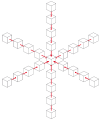What is a Stencil in Parallel Computing Paradigm?

I have come across the word ‘stencil’ a lot within the parallel computing community but I still do not know what it is all about. What is stencil and what is the function of using a stencil with a parallel code? How does stencil enhance the performance of a parallel computer code?
















